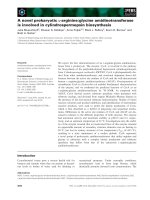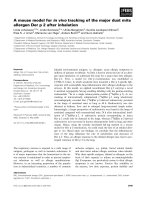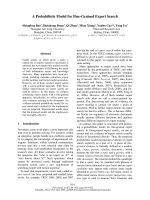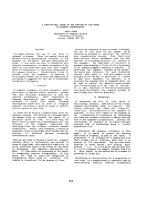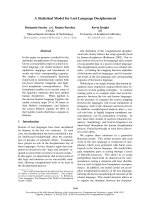Báo cáo y học: "A mathematical model for the adenylosuccinate synthetase reaction involved in purine biosynthesis" pot
Bạn đang xem bản rút gọn của tài liệu. Xem và tải ngay bản đầy đủ của tài liệu tại đây (833.4 KB, 11 trang )
BioMed Central
Page 1 of 11
(page number not for citation purposes)
Theoretical Biology and Medical
Modelling
Open Access
Research
A mathematical model for the adenylosuccinate synthetase
reaction involved in purine biosynthesis
Evgeniya A Oshchepkova-Nedosekina* and Vitalii A Likhoshvai
Address: Institute of Cytology and Genetics SB RAS, Novosibirsk, Russia
Email: Evgeniya A Oshchepkova-Nedosekina* - ; Vitalii A Likhoshvai -
* Corresponding author
Abstract
Background: Development of the mathematical models that adequately describe biochemical
reactions and molecular-genetic mechanisms is one of the most important tasks in modern
bioinformatics. Because the enzyme adenylosuccinate synthetase (AdSS) has long been extensively
studied, a wealth of kinetic data has been accumulated.
Results: We describe a mathematical model for the reaction catalyzed by AdSS. The model's
parameters were fitted to experimental data obtained from published literature. The advantage of
our model is that it includes relationships between the reaction rate, the concentrations of three
substrates (GTP, IMP and ASP), the effects of five inhibitors (GMP, GDP, AMP, ASUC and SUCC),
and the influence of Mg
2+
ions.
Conclusion: Our model describes the reaction catalyzed by AdSS as a fully random process. The
model structure implies that each of the inhibitors included in it is only competitive to one of the
substrates. The model was tested for adequacy using experimental data published elsewhere. The
values obtained for the parameters are as follows: V
max
= 1.35·10
-3
mM/min, Km
GTP
= 0.023 mM,
Km
IMP
= 0.02 mM, Km
ASP
= 0.3 mM, Ki
GMP
= 0.024 mM, Ki
GDP
= 8·10
-3
mM, Ki
AMP
= 0.01 mM, Ki
ASUC
=
7.5·10
-3
mM, Ki
SUCC
= 8 mM, Km
Mg
= 0.08 mM.
Background
Biosynthesis of the purines AMP and GMP in Escherichia
coli is a many-staged process supported by a complex net-
work of enzymes. Some of the genes that encode these
enzymes are arranged into operons (purF, purHD, purMN,
purEK, guaBA, purB), while others are located in single cis-
trons (purT, purl, purC, purA, guaC). Expression of these
operons is regulated by regulatory proteins (PurR, DnaA,
CRP) and various low-molecular-weight compounds [1-
3]. The activities of the encoded enzymes are additionally
regulated by substrates, reaction products, and certain
other low-molecular-weight substances [4,5].
The enzyme adenylosuccinate synthetase (AdSS; GDP-
forming IMP: L-aspartate ligase, EC 6.3.4.4), which is the
product of the purA gene, catalyzes the conversion of IMP
to ASUC in the presence of Mg
2+
:
IMP + GTP + ASP → GDP + PI + ASUC.
There are many nucleotides that inhibit AdSS. For exam-
ple, AMP is a competitive inhibitor of IMP; ASUC, of IMP;
dGMP, of IMP; GMP, of GTP. GDP is a competitive inhib-
itor of GTP, which in part explains a gradual decrease in
the rate of ASUC formation in solutions if the GTP con-
centration is not reduced. dAMP, CMP, and UMP can also
Published: 27 February 2007
Theoretical Biology and Medical Modelling 2007, 4:11 doi:10.1186/1742-4682-4-11
Received: 25 September 2006
Accepted: 27 February 2007
This article is available from: />© 2007 Oshchepkova-Nedosekina and Likhoshvai; licensee BioMed Central Ltd.
This is an Open Access article distributed under the terms of the Creative Commons Attribution License ( />),
which permits unrestricted use, distribution, and reproduction in any medium, provided the original work is properly cited.
Theoretical Biology and Medical Modelling 2007, 4:11 />Page 2 of 11
(page number not for citation purposes)
produce inhibitory effects, albeit much less pronounced
[6].
Mathematical models of the reaction catalyzed by AdSS
have been proposed in a variety of studies. In 1969,
Rudolph and Fromm proposed an equation that includes
one inhibitor [7]. It was demonstrated that each of SUCC,
GDP, and IMP is a competitive inhibitor of only one sub-
strate and that the molecular mechanism of the reaction
catalyzed by AdSS is a rapid equilibrium, fully random
process. To describe the dependence of the reaction rate
on whether the inhibitor competes against the substrate
for binding to the enzyme, an 11-parameter model was
proposed. Although the kinetics of the AdSS-catalyzed
reaction in the presence of the inhibitors SUCC, GDP,
IMP, and ASUC was well studied experimentally, the for-
mula included too many constants and the model con-
stants (including the inhibition constants) were not
evaluated.
In 1979, Stayton and Fromm proposed a slightly different
equation for one inhibitor [8]. In this case, the inhibition
of AdSS by ppGpp was considered. It was demonstrated
that ppGpp is a competitive inhibitor of GTP, but not of
IMP or ASP. This model also describes the effect of the
inhibitor using four inhibition constants, so only the
apparent values of these constants were calculated. Inter-
estingly, varying the concentrations of IMP or GTP (at
fixed concentrations of the other two substrates) affected
the calculated values of the respective inhibition con-
stants.
In 1995, Kang and Fromm investigated the influence of
Mg
2+
ions on the AdSS-catalyzed reaction [9]. It was dem-
onstrated that for AdSS to be in the activated form, two
Mg
2+
ions are required. One interacts with the β- and γ-
phosphoryl groups of GTP, the other with the aspartate in
the enzyme's active center, improving the affinity of the
enzyme for ASP. Kinetic experiments on the interactions
of Mg
2+
and ASP were performed with saturating concen-
trations of GTP and IMP, so the GTP and IMP concentra-
tions were not included in the model. Although the
authors themselves proved that AdSS has two binding
centers for Mg
2+
, the model treats the Mg
2+
concentration
as if there were only one (at least this is how we interpret
the presence of ion concentration as an item raised to the
first power). The initial velocity in the Hill plot (Fig. 1 in
[9]) was measured at saturating concentrations of IMP,
GTP and Asp with Mg
2+
varying.
Thus, although a model has been proposed for each of a
variety of effectors, there is still no single model that
exploits the pool of available kinetic data in its entirety.
We report a more complete model, which describes the
reaction catalyzed by adenylosuccinate synthetase and
includes the concentrations of three substrates (GTP, IMP,
and ASP), the effects of five inhibitors (GMP, GDP, AMP,
ASUC, and SUCC), and the influence of Mg
2+
ions.
Results
The enzyme AdSS is inhibited by GMP, GDP, AMP, ASUC
and SUCC. Enzyme activity requires the presence of Mg
2+
ions. Knowing how these effectors work, the reaction rate
can be written in a generalized form as follows:
where V
max
is the maximum reaction rate; GTP, IMP, and
ASP are the concentrations of the corresponding sub-
strates; GMP, GDP, AMP, ASUC, and SUCC are the con-
centrations of the corresponding inhibitors; Mg
2+
is the
concentration of Mg
2+
ions; Km
GTP
, Km
IMP
, Km
ASP
are the
Michaelis-Menten constants for the corresponding sub-
strates; Km
Mg
is the Michaelis-Menten constant for Mg
2+
ions; Ki
GMP
, Ki
GDP
, Ki
AMP
, Ki
ASUC
, and Ki
SUCC
, are the con-
stants of the efficiency of reaction inhibition by the corre-
sponding substances.
The model's parameters were verified against 61 curves
from published data [6,7,9]. Different publications use
different values of the rate constant of AdSS: 15600 s
-1
[10], 1.47 s
-1
[9], 1.0 s
-1
[11]. However, since most publi-
cations do not indicate the enzyme concentrations used,
we calculated the value for V
max
using our model.
We evaluated the reaction constants in the absence of
effectors using experimental results from the work by
Rudolph and Fromm [7] and observed good agreement
(calculations not shown). The parameter values inferred
from the curves were as follows: V
max
= 1.35·10
-3
mM min
-
1
, Km
GTP
= 0.023 mM, Km
IMP
= 0.02 mM, Km
ASP
= 0.3 mM.
Rudolph and Fromm, who examined the effect of SUCC
in detail [7], proposed that SUCC is competitive to ASP.
Our calculations indicate that this assumption is consist-
ent with the kinetic data. The model output and experi-
mental data on how SUCC affects the reaction rate at
different concentrations of GTP are presented in Fig. 1. As
can be seen from this figure, there is an inconsistency
between the model output and experimental data. A pos-
sible explanation will be discussed below. Also, we esti-
mated the effect of SUCC on the reaction rate at different
concentrations of IMP and ASP and observed good agree-
ment with experimental data (calculations not shown).
Using our model, the value of the constant Ki
SUCC
is 8
mM.
GDP is a competitive inhibitor of GTP. Based on experi-
mental data from the work by Rudolph and Fromm [7],
VV
GTP
Km
IMP
Km
ASP
Km
GTP
Km
GMP
Ki
GDP
Ki
GTP IMP ASP
GTP GMP
=⋅
⋅⋅
+++
max
1
GGDP IMP AMP ASUC ASP
IMP
Km
AMP
Ki
ASUC
Ki
ASP
Km
⎛
⎝
⎜
⎞
⎠
⎟
⋅+ + +
⎛
⎝
⎜
⎞
⎠
⎟
⋅+11
++
⎛
⎝
⎜
⎞
⎠
⎟
⋅
+
()
+
+
SUCC
Ki
Mg
Km
Mg
Km
SUCC
Mg
Mg
2
2
1
1,
Theoretical Biology and Medical Modelling 2007, 4:11 />Page 3 of 11
(page number not for citation purposes)
Relationships between the reaction rate and the concentration of GTP in the presence of SUCCFigure 1
Relationships between the reaction rate and the concentration of GTP in the presence of SUCC. SUCC concen-
trations were (black line and circles) 50 mM; (red line and circles) 25 mM; (brown line and circles) 12.5 mM; (crimson line and
circles) 0. Experimental data from [7].
Theoretical Biology and Medical Modelling 2007, 4:11 />Page 4 of 11
(page number not for citation purposes)
we evaluated Ki
GDP
as 8·10
-3
mM (calculations not
shown).
Wyngaarden and Greenland [6] investigated the effect of
ASUC, another inhibitor, and proposed that it is compet-
itive with both IMP and ASP. Likewise, it was proposed
that GMP is a competitive inhibitor of both IMP and GTP.
However, our calculations suggest that ASUC appears to
be competitive with only IMP, and GMP with only GTP.
The effects of ASUC on IMP and ASP and the model out-
put are presented in Figs. 2, 3. Using the model, Ki
ASUC
is
7.5·10
-3
mM.
The influence of Mg
2+
ions on enzyme activity is included
in our model on the basis of the kinetic curves presented
in the work of Kang and Fromm [9]. The concentration of
Mg
2+
is included as a multiplier in the form of a simple
rational fraction raised to the first power. Kang and
Fromm also included the concentration of Mg
2+
as a mul-
tiplier raised to the first power; however, they additionally
assumed that Mg
2+
and ASP may act cooperatively. Our
calculations demonstrate that an even simpler model,
which does not assume Mg
2+
/ASP synergy, is adequate for
describing the influence of magnesium. Although our
model does not say that there are two binding sites for
Mg
2+
ions, nor does it say otherwise [12], for it is not nec-
essary that Hill's number be the same as the number of lig-
and-binding centers in the enzyme. Using our model,
Km
Mg
is 0.08 mM (Fig. 4).
Also, our model treats AMP as a competitive inhibitor of
IMP [6]. From the work of Wyngaarden and Greenland
[6], we calculated the constants of the GMP and AMP
effects (Fig. 5, lines 1 and 2): Ki
GMP
= 0.024 mM, Ki
AMP
=
0.01 mM. However, these estimates may suffer from a lack
of consistency within the experimental data.
In control experiments, we used data from Wyngaarden
and Greenland [6]. The comparison of the model output
and experimental data [6] is presented in Fig. 5, lines 4
and 5. For comparison, the values of the constants
obtained here and elsewhere are presented in Table 1.
Discussion
Models to describe the reaction catalyzed by adenylosuc-
cinate synthetase have been proposed from time to time.
In 1969, Rudolph and Fromm investigated the mecha-
nism of this reaction and proposed an equation that
related the reaction rate to the respective concentrations of
the substrates and one inhibitor [7]. However, the for-
mula included four inhibition constants and therefore
was too complicated to allow those constants to be evalu-
ated. As a result, only apparent inhibition constants were
calculated.
In 1963, Wyngaarden and Greenland [6] proposed that
ASUC is a competitive inhibitor of both IMP and ASP.
Likewise, it was proposed that GMP is a competitive
inhibitor of both IMP and GTP. However, our model,
using the same pool of experimental data, demonstrates
that the assumption that ASUC is competitive with only
IMP, and GMP with only GTP, is sufficient for describing
the enzyme reaction adequately.
In 1979, Stayton and Fromm [8] proposed a model that
relates the reaction rate to the effect of the inhibitor
ppGpp. This model describes the effect of the inhibitor as
the above model does, so only the apparent inhibition
constants were calculated. In addition, the calculated val-
ues of these apparent inhibition constants depend on the
substrate concentrations.
In 1995, Kang and Fromm [9] proposed a model that
relates the reaction rate to the concentrations of ASP and
Mg
2+
ions. However, no other substrates or inhibitors
were included. Thus, despite all the interest in the reaction
catalyzed by AdSS, no single model that includes the con-
centrations of all substrates and the effects of more than
one effector has been proposed. We propose a model that
describes the reaction catalyzed by adenylosuccinate syn-
thetase and includes the concentrations of three substrates
(GTP, IMP, and ASP), the effects of five inhibitors (GMP,
GDP, AMP, ASUC, and SUCC), and the influence of Mg
2+
ions. Our model is consistent with a fully random mech-
anism, which is very similar to that proposed by Rudolph
and Fromm [7]. However, given the available biochemical
data on the reaction mechanism, at least two alternative
hypotheses could be put forward. We checked whether
these hypotheses were consistent with the kinetic data.
One of these hypotheses states that magnesium binds to
aspartate to form an ASP·Mg
2+
complex, which in turn
binds to the enzyme. This hypothesis leads to a modifica-
tion of our model such that it describes the effects of ASP,
Mg, and SUCC. To make this modified model consistent
with experimental data at a fixed concentration of Mg
2+
,
all the parameters, except Km
Mg
, were assigned the same
values as in the original model. The best consistency of the
modified model and the experimental data was attained
at Km
Mg
= 0.01 mM. Overall, this modification is much
less consistent with the experimental data than the origi-
nal model (calculations not shown).
The second hypothesis states that ASP binds to the
enzyme to form an AdSS·ASP complex, after which mag-
nesium binds to aspartate in that complex. To describe
this hypothesis, another modification of the original
model is required such that it describes the effects of ASP,
Mg, and SUCC. Here the best consistency is attained at
Km
Mg
= 0.13 mM. Overall, this modification too fails to
Theoretical Biology and Medical Modelling 2007, 4:11 />Page 5 of 11
(page number not for citation purposes)
Relationships between the reaction rate and the IMP concentration in the presence/absence of ASUCFigure 2
Relationships between the reaction rate and the IMP concentration in the presence/absence of ASUC. Experi-
mental data from [7].
Theoretical Biology and Medical Modelling 2007, 4:11 />Page 6 of 11
(page number not for citation purposes)
show reasonable consistency with the experimental data
(calculations not shown).
Under both modified models (one assuming pre-forma-
tion of the ASP·Mg
2+
complex, the other assuming pre-
formation of the AdSS·ASP complex), magnesium com-
petes against SUCC, while under the original model it
does not compete against anything. Looking at the output
from the original and modified models, it is easy to see
that the original is by far the most consistent. Admittedly,
Relationships between the reaction rate and the ASP concentration in the presence/absence of ASUCFigure 3
Relationships between the reaction rate and the ASP concentration in the presence/absence of ASUC. Experi-
mental data from [7].
Theoretical Biology and Medical Modelling 2007, 4:11 />Page 7 of 11
(page number not for citation purposes)
Relationships between the reaction rate and concentration of Mg2+ ions at varying concentrations of ASPFigure 4
Relationships between the reaction rate and concentration of Mg2+ ions at varying concentrations of ASP.
Experimental data from [9].
Theoretical Biology and Medical Modelling 2007, 4:11 />Page 8 of 11
(page number not for citation purposes)
Relationships between the reaction rate and concentration of ASP under different conditionsFigure 5
Relationships between the reaction rate and concentration of ASP under different conditions. Experimental data
from [6].
Theoretical Biology and Medical Modelling 2007, 4:11 />Page 9 of 11
(page number not for citation purposes)
it seems in some respects inconsistent with the available
biochemical data: for example, it leaves out the presence
of two binding sites for Mg
2+
. Therefore, this model may
not be claimed as an absolutely accurate description of the
real molecular events unfolding in the reaction being dis-
cussed. Looking at the model structure, it appears as
though magnesium ions might act on the enzyme via their
own independent centers. This hypothetical mechanism
therefore deserves to be called an "apparent molecular
mechanism" by analogy with apparent dissociation con-
stants, apparent inhibition constants, etc.
As we were working on our model, an inconsistency
between the model output and the experimental data on
SUCC was revealed (Fig. 1). Since no enzyme concentra-
tions were specified in the literature sources to which we
referred, we kept to a fixed arbitrary concentration of the
enzyme in all the numerical experiments. However, when
we proceeded to SUCC, we found that we had to modify
this concentration in order to keep the model consistent
with experimental data. We introduced a multiplier equal
to 0.74 as a correction factor, which implies a reduction in
the concentration of the enzyme (calculations not
shown).
The constant Km
Mg
was verified against data published by
Kang and Fromm [9] (Fig. 4). However, to accomplish
this, we had to reduce Km
ASP
two-fold to 0.17 mM and
introduce a correction factor (a multiplier equal to 5000),
which in effect increases the amount of enzyme. The other
model parameters were absolutely consistent with those
experimental data.
Some data from Wyngaarden and Greenland [6] were
used for control experiments (Fig. 5, lines 4 and 5). On
comparing our model output and the control data, an
apparent inconsistency was revealed. It is possible that the
authors used different amounts of the enzyme in different
experiments. This assumption was supported by introduc-
tion of a coefficient such as those used for the curves
shown in Fig. 1. Admittedly, the discrepancies revealed
during the fitting of the parameters could in part be
explained by the different temperatures at which the dif-
ferent authors conducted their experiments: Rudolph and
Fromm [7] at 28°C, Wyngaarden and Greenland [6] at
25°C, and Kang and Fromm [9] at 22°C. However, in the
present work we did not look at temperature as a factor.
Conclusion
The proposed model for the reaction catalyzed by the
enzyme AdSS includes relationships between the reaction
rate, the concentrations of three substrates (GTP, IMP and
ASP), the effects of five inhibitors (GMP, GDP, AMP,
ASUC and SUCC) and Mg
2+
ions. Our model is consistent
Table 1: Kinetic parameters of Escherichia coli adenylosuccinate synthetase. Our model output, and data provided from the
literature.
Parameter Model output Literature data Reference
Km
GTP
0.023 mM 0.01 mM 7
0.048 mM 6
0.0221 mM 10
0.0262 ± 0.0023 mM 12
Km
IMP
0.02 mM 0.02 mM 7
0.054 mM 6
0.0243 mM 10
0.0278 ± 0.0013 mM 12
Km
ASP
0.3 mM 0.35 mM 7
0.225 ± 0.016 mM 9
0.27 mM 6
0.191 mM 10
0.23 ± 0.04 mM 12
Ki
SUCC
*8 mM - -
Ki
GDP
0.008 mM 0.022 mM 6
Ki
ASUC
0.0075 mM 0.27 mM (for IMP)** 6
0.47 mM (for ASP) 6
Km
Mg
0.08 mM 0.114 ± 0.026 mM 9
Ki
GMP
0.024 mM 0.092 mM (for GTP) 6
0.074 mM (for IMP) 6
Ki
AMP
0.01 mM 0.095 mM 6
* The effect of SUCC was examined by Rudolph and Fromm [7]. However, their formula is too complicated (it describes the effect of one inhibitor
using four different constants) and the inhibition constants were not evaluated.
** In 1963 Wyngaarden and Greenland [6] proposed that ASUC is a competitive inhibitor of both IMP and ASP, and GMP is a competitive inhibitor
of both IMP and GTP.
Theoretical Biology and Medical Modelling 2007, 4:11 />Page 10 of 11
(page number not for citation purposes)
with a fully random mechanism. The model structure
implies that each of the inhibitors included in it is com-
petitive to only one of the substrates. The model's param-
eters were fitted to experimental data from published
literature. A methodological problem arising from the
lack of concordance among the data in different publica-
tions was dealt with by introducing correction coeffi-
cients; this simply implies that the concentrations of AdSS
in those source works were different. The adequacy of the
model was ensured by comparing the theoretical calcula-
tions and the experimental data from the literature
sources that were not used while the fitting procedure was
under way. The values obtained for the parameters are
shown in Table 1.
Methods
The model to describe the reaction catalyzed by adenylo-
succinate synthetase was developed using a random bio-
chemical system as follows:
Equation (a) describes the interaction of GTP or GDP or
GMP with its respective active center. It is assumed that
GTP, GDP and GMP compete against one another for
binding to the same center, which is why X stands for GTP
or GDP or GMP. It is assumed that the population of the
other enzyme centers has no effect on reactions (a). Equa-
tion (b) describes the interaction of IMP or AMP or ASUC
with a different active center. Y stands for IMP or AMP or
ASUC. Equation (c) describes the interaction of ASP and
SUCC with a third active center, Z standing for either ASP
or SUCC. Finally, Equation (d) describes the interaction
of magnesium ions with the enzyme; here W stands for
Mg. E(x, y, z, w) describes the state of the enzyme: x is
assigned 0, GTP, GDP or GMP; y is assigned 0, IMP, AMP
or ASUC; z is assigned 0, ASP, and SUCC; w is assigned
either 0 or Mg. If a variable in E(x, y, z, w) takes on a zero
value, it means that the corresponding enzyme center is
not bound to the ligand.
Owing to the assumption that the system is random, the
variables X, x, Y, y, Z, z, W, w in Equations (a)-(d) are
always independent. Therefore, Equations (a) and (b)
each include 72 reactions and Equation (c) includes 64
reactions. Equation (d) is a concise description of 48 reac-
tions. Overall, the system (a)-(d) includes 256 biochemi-
cal reactions that describe transitions among 96 states of
the enzyme. Writing out the corresponding system of 96
differential equations and assuming equilibrium results
in a non-linear algebraic system. Supposing that variation
in the concentrations of GTP, GDP, GMP, IMP, AMP,
ASUC, ASP, SUCC and Mg
2+
can be neglected, we arrive at
the corresponding system of linear equations defining a
96-dimensional vector of the unknown states of the
enzyme. Solving this system and collecting similar terms
and assuming that Km
GTP
≡ K
GTP
, Ki
GDP
≡ K
GDP
, Ki
GMP
≡
K
GMP
, Km
IMP
≡ K
IMP
, Ki
AMP
≡ K
AMP
, Ki
ASUC
≡ K
ASUC
, Km
ASP
≡
K
ASP
, Ki
SUCC
≡ K
SUCC
, Km
Mg
≡ K
Mg
, we obtain the proposed
model.
Abbreviations
AdSS, adenylosuccinate synthetase; AMP, adenosine 5'-
monophosphate; ASP, aspartate; ASUC, adenylosucci-
nate; CMP, cytidine-5'-monophosphate; dAMP, deoxya-
denylic acid; dGMP, deoxyguanylic acid; GDP, guanosine
5'-diphosphate; GMP, guanosine 5'-phosphate; GTP, gua-
nosine 5'-triphosphate; IMP, inosine 5'-monophosphate;
PI, phosphate; ppGpp, guanosine 5'-diphosphate-3'-
diphosphate; SUCC, succinate; UMP, uridine 5'-mono-
phosphate.
Competing interests
The author(s) declare that they have no competing inter-
ests.
Authors' contributions
OEA was responsible for developing of the model, and
writing of the manuscript.
LVA was responsible for developing of the modelling
method and critical review of the manuscript.
Acknowledgements
The authors are grateful to I. V. Lokhova for bibliographical support and V.
Filonenko for translation of the paper into English.
This work was supported in part by the Russian Foundation for Basic
Research No 05-07-98011-r_ob_v, 05-07-98012-r_ob_v, 06-04-49556-a,
NSF:FIBR (Grant EF-0330786) and by the Rosnauka (State Contract No.
02.467.11.1005).
References
1. He B, Shiau A, Choi KY, Zalkin H, Smith JM: Genes of the
Escherichia coli pur regulon are negatively controlled by a
repressor-operator interaction. J Bacteriol 1990, 172:4555-4562.
2. Hutchings MI, Drabble WT: Regulation of the divergent guaBA
and xseA promoters of Escherichia coli by the cyclic AMP
receptor protein. FEMS Microbiol Lett 2000, 187:115-122.
3. Mehra RK, Drabble WT: Dual control of the gua operon of
Escherichia coli K12 by adenine and guanine nucleotides. J
Gen Microbiol 1981, 123:27-37.
4. Messenger LJ, Zalkin H: Glutamine phosphoribosylpyrophos-
phate amidotransferase from Escherichia coli. Purification
and properties. J Biol Chem 1979, 254:3382-3392.
5. Lambden PR, Drabble WT: Inosine 5'-monophosphate dehydro-
genase of Escherichia coli K12: the nature of the inhibition by
guanosine 5'-monophosphate. Biochem J 1973, 133:607-608.
a
b
c
() ( )
+⇔
()
() ( )
+⇔
()
(
E yzw X E Xyzw
Ex zw Y ExYzw
K
K
X
Y
0
0
,,, ,,,
,,, , ,,
))( )
+⇔
()
() ( )
+⇔
()
Exy w Z ExyZw
Exyz W ExyzW
K
K
Z
W
,,, ,, ,
,,, ,,, .
0
0d
Publish with BioMed Central and every
scientist can read your work free of charge
"BioMed Central will be the most significant development for
disseminating the results of biomedical research in our lifetime."
Sir Paul Nurse, Cancer Research UK
Your research papers will be:
available free of charge to the entire biomedical community
peer reviewed and published immediately upon acceptance
cited in PubMed and archived on PubMed Central
yours — you keep the copyright
Submit your manuscript here:
/>BioMedcentral
Theoretical Biology and Medical Modelling 2007, 4:11 />Page 11 of 11
(page number not for citation purposes)
6. Wyngaarden JB, Greenland RA: The inhibition of succinoade-
nylate kinosynthetase of Escherichia coli by adenosine and
guanosine 5'-monophosphates. J Biol Chem 1963,
238:1054-1057.
7. Rudolph FB, Fromm HJ: Initial rate studies of adenylosuccinate
synthetase with product and competitive inhibitors. J Biol
Chem 1969, 244:3832-3839.
8. Stayton MM, Fromm HJ: Guanosine 5'-diphosphate-3'-diphos-
phate inhibition of adenylosuccinate synthetase. J Biol Chem
1979, 254:2579-2581.
9. Kang C, Fromm HJ: Identification of an essential second metal
ion in the reaction mechanism of Escherichia coli adenylo-
succinate synthetase. J Biol Chem 1995, 270:15539-15544.
10. Dong Q, Liu F, Myers AM, Fromm HJ: Evidence for an arginine
residue at the substrate binding site of Escherichia coli ade-
nylosuccinate synthetase as studied by chemical modifica-
tion and site-directed mutagenesis. J Biol Chem 1991,
266:12228-12233.
11. Wang W, Gorrell A, Hou Z, Honzatko RB, Fromm HJ: Ambiguities
in mapping the active site of a conformationally dynamic
enzyme by directed mutation. Role of dynamics in structure-
function correlations in Escherichia coli adenylosuccinate
synthetase. J Biol Chem 1998, 273:16000-16004.
12. Cornish-Bowden A: Principles of enzyme kinetics London: Butterworth;
1976.


